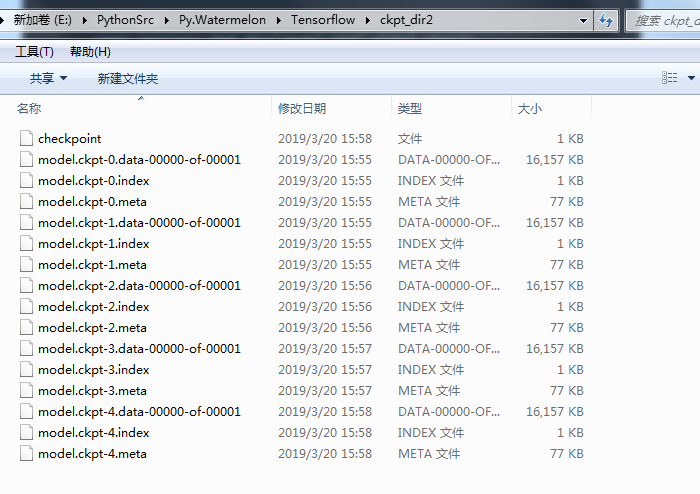模型训练和保存
import tensorflow as tf
from tensorflow.examples.tutorials.mnist import input_data
import numpy as np
import os
# 屏蔽waring信息
os.environ['TF_CPP_MIN_LOG_LEVEL'] = '2'
"""------------------加载数据---------------------"""
# 载入数据
mnist = input_data.read_data_sets("MNIST_data/", one_hot=True)
trX, trY, teX, teY = mnist.train.images, mnist.train.labels, mnist.test.images, mnist.test.labels
# 改变数据格式,为了能够输入卷积层
trX = trX.reshape(-1, 28, 28, 1) # -1表示不考虑输入图片的数量,1表示单通道
teX = teX.reshape(-1, 28, 28, 1)
"""------------------构建模型---------------------"""
# 定义输入输出的数据容器
X = tf.placeholder("float", [None, 28, 28, 1])
Y = tf.placeholder("float", [None, 10])
# 定义和初始化权重、dropout参数
def init_weights(shape):
return tf.Variable(tf.random_normal(shape, stddev=0.01))
w1 = init_weights([3, 3, 1, 32]) # 3X3的卷积核,获得32个特征
w2 = init_weights([3, 3, 32, 64]) # 3X3的卷积核,获得64个特征
w3 = init_weights([3, 3, 64, 128]) # 3X3的卷积核,获得128个特征
w4 = init_weights([128 * 4 * 4, 625]) # 从卷积层到全连层
w_o = init_weights([625, 10]) # 从全连层到输出层
p_keep_conv = tf.placeholder("float")
p_keep_hidden = tf.placeholder("float")
# 定义模型
def create_model(X, w1, w2, w3, w4, w_o, p_keep_conv, p_keep_hidden):
# 第一组卷积层和pooling层
conv1 = tf.nn.conv2d(X, w1, strides=[1, 1, 1, 1], padding='SAME')
conv1_out = tf.nn.relu(conv1)
pool1 = tf.nn.max_pool(conv1_out, ksize=[1, 2, 2, 1], strides=[1, 2, 2, 1], padding='SAME')
pool1_out = tf.nn.dropout(pool1, p_keep_conv)
# 第二组卷积层和pooling层
conv2 = tf.nn.conv2d(pool1_out, w2, strides=[1, 1, 1, 1], padding='SAME')
conv2_out = tf.nn.relu(conv2)
pool2 = tf.nn.max_pool(conv2_out, ksize=[1, 2, 2, 1], strides=[1, 2, 2, 1], padding='SAME')
pool2_out = tf.nn.dropout(pool2, p_keep_conv)
# 第三组卷积层和pooling层
conv3 = tf.nn.conv2d(pool2_out, w3, strides=[1, 1, 1, 1], padding='SAME')
conv3_out = tf.nn.relu(conv3)
pool3 = tf.nn.max_pool(conv3_out, ksize=[1, 2, 2, 1], strides=[1, 2, 2, 1], padding='SAME')
pool3 = tf.reshape(pool3, [-1, w4.get_shape().as_list()[0]]) # 转化成一维的向量
pool3_out = tf.nn.dropout(pool3, p_keep_conv)
# 全连层
fully_layer = tf.matmul(pool3_out, w4)
fully_layer_out = tf.nn.relu(fully_layer)
fully_layer_out = tf.nn.dropout(fully_layer_out, p_keep_hidden)
# 输出层
out = tf.matmul(fully_layer_out, w_o)
return out
model = create_model(X, w1, w2, w3, w4, w_o, p_keep_conv, p_keep_hidden)
# 定义代价函数、训练方法、预测操作
cost = tf.reduce_mean(tf.nn.softmax_cross_entropy_with_logits(logits=model, labels=Y))
train_op = tf.train.RMSPropOptimizer(0.001, 0.9).minimize(cost)
predict_op = tf.argmax(model, 1,name="predict")
# 定义一个saver
saver=tf.train.Saver()
# 定义存储路径
ckpt_dir="./ckpt_dir2"
if not os.path.exists(ckpt_dir):
os.makedirs(ckpt_dir)
"""------------------训练模型---------------------"""
train_batch_size = 128 # 训练集的mini_batch_size=128
test_batch_size = 256 # 测试集中调用的batch_size=256
epoches = 5 # 迭代周期
with tf.Session() as sess:
"""-------训练模型--------"""
# 初始化所有变量
tf.global_variables_initializer().run()
# 训练操作
for i in range(epoches):
train_batch = zip(range(0, len(trX), train_batch_size),
range(train_batch_size, len(trX) + 1, train_batch_size))
for start, end in train_batch:
sess.run(train_op, feed_dict={X: trX[start:end], Y: trY[start:end],
p_keep_conv: 0.8, p_keep_hidden: 0.5})
# 每个周期用测试集中随机抽出test_batch_size个图片进行测试
test_indices = np.arange(len(teX)) # 返回一个array[0,1...len(teX)]
np.random.shuffle(test_indices) # 打乱这个array
test_indices = test_indices[0:test_batch_size]
# 获取测试集test_batch_size章图片的的预测结果
predict_result = sess.run(predict_op, feed_dict={X: teX[test_indices],
p_keep_conv: 1.0,
p_keep_hidden: 1.0})
# 获取真实的标签值
true_labels = np.argmax(teY[test_indices], axis=1)
# 计算准确率
accuracy = np.mean(true_labels == predict_result)
print("epoch", i, ":", accuracy)
# 保存模型
saver.save(sess,ckpt_dir+"/model.ckpt",global_step=i)
输出:
Extracting MNIST_data/train-images-idx3-ubyte.gz
Extracting MNIST_data/train-labels-idx1-ubyte.gz
Extracting MNIST_data/t10k-images-idx3-ubyte.gz
Extracting MNIST_data/t10k-labels-idx1-ubyte.gz
epoch 0 : 0.953125
epoch 1 : 0.98828125
epoch 2 : 0.984375
epoch 3 : 0.99609375
epoch 4 : 0.9921875
存储路径:
训练的时候,因为只有CPU,所以我只跑了5个迭代周期。
用Saver保存的模型的恢复
# 用Saver保存的模型的恢复
import tensorflow as tf
import numpy as np
import os
import cv2
# 屏蔽waring信息
os.environ['TF_CPP_MIN_LOG_LEVEL'] = '2'
"""------------------构建模型---------------------"""
# 定义输入输出的数据容器
X = tf.placeholder("float", [None, 28, 28, 1])
Y = tf.placeholder("float", [None, 10])
# 定义和初始化权重、dropout参数
def init_weights(shape):
return tf.Variable(tf.random_normal(shape, stddev=0.01))
w1 = init_weights([3, 3, 1, 32]) # 3X3的卷积核,获得32个特征
w2 = init_weights([3, 3, 32, 64]) # 3X3的卷积核,获得64个特征
w3 = init_weights([3, 3, 64, 128]) # 3X3的卷积核,获得128个特征
w4 = init_weights([128 * 4 * 4, 625]) # 从卷积层到全连层
w_o = init_weights([625, 10]) # 从全连层到输出层
p_keep_conv = tf.placeholder("float")
p_keep_hidden = tf.placeholder("float")
# 定义模型
def create_model(X, w1, w2, w3, w4, w_o, p_keep_conv, p_keep_hidden):
# 第一组卷积层和pooling层
conv1 = tf.nn.conv2d(X, w1, strides=[1, 1, 1, 1], padding='SAME')
conv1_out = tf.nn.relu(conv1)
pool1 = tf.nn.max_pool(conv1_out, ksize=[1, 2, 2, 1], strides=[1, 2, 2, 1], padding='SAME')
pool1_out = tf.nn.dropout(pool1, p_keep_conv)
# 第二组卷积层和pooling层
conv2 = tf.nn.conv2d(pool1_out, w2, strides=[1, 1, 1, 1], padding='SAME')
conv2_out = tf.nn.relu(conv2)
pool2 = tf.nn.max_pool(conv2_out, ksize=[1, 2, 2, 1], strides=[1, 2, 2, 1], padding='SAME')
pool2_out = tf.nn.dropout(pool2, p_keep_conv)
# 第三组卷积层和pooling层
conv3 = tf.nn.conv2d(pool2_out, w3, strides=[1, 1, 1, 1], padding='SAME')
conv3_out = tf.nn.relu(conv3)
pool3 = tf.nn.max_pool(conv3_out, ksize=[1, 2, 2, 1], strides=[1, 2, 2, 1], padding='SAME')
pool3 = tf.reshape(pool3, [-1, w4.get_shape().as_list()[0]]) # 转化成一维的向量
pool3_out = tf.nn.dropout(pool3, p_keep_conv)
# 全连层
fully_layer = tf.matmul(pool3_out, w4)
fully_layer_out = tf.nn.relu(fully_layer)
fully_layer_out = tf.nn.dropout(fully_layer_out, p_keep_hidden)
# 输出层
out = tf.matmul(fully_layer_out, w_o)
return out
model = create_model(X, w1, w2, w3, w4, w_o, p_keep_conv, p_keep_hidden)
# 定义代价函数、训练方法、预测操作
cost = tf.reduce_mean(tf.nn.softmax_cross_entropy_with_logits(logits=model, labels=Y))
train_op = tf.train.RMSPropOptimizer(0.001, 0.9).minimize(cost)
predict_op = tf.argmax(model, 1,name="predict")
# 定义一个saver
saver=tf.train.Saver()
# 定义存储路径
ckpt_dir="./ckpt_dir2"
with tf.Session() as sess:
"""-----加载模型,用导入的图片进行测试--------"""
# 载入图片
src = cv2.imread('./Pictures/8.png')
cv2.imshow("Pending pictures", src) # 待测图片
# 将图片转化为28*28的灰度图
src = cv2.cvtColor(src, cv2.COLOR_BGR2GRAY)
dst = cv2.resize(src, (28, 28), interpolation=cv2.INTER_CUBIC)
# 将灰度图转化为1*784的能够输入的网络的数组
picture = np.zeros((28, 28))
for i in range(0, 28):
for j in range(0, 28):
picture[i][j] = (255 - dst[i][j])
picture = picture.reshape(1, 28, 28, 1)
# 载入模型
saver.restore(sess,ckpt_dir+"/model.ckpt-4")
# 进行预测
predict_result = sess.run(predict_op, feed_dict={X: picture,
p_keep_conv: 1.0,
p_keep_hidden: 1.0})
print("你导入的图片是:",predict_result[0])
cv2.waitKey(20190320)
# 关闭会话
sess.close()
输出:
你导入的图片是: 8
注意:
- 用MINIST训练出来的模型。主要用来识别手写数字的,而且对输入的图片要求是近似黑底白字的,所以如果图片预处理不合适会导致识别率不高。
- 如果直接用官方的图片输 入,则识别完全没问题

